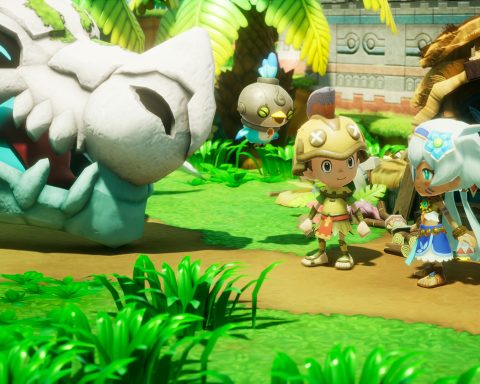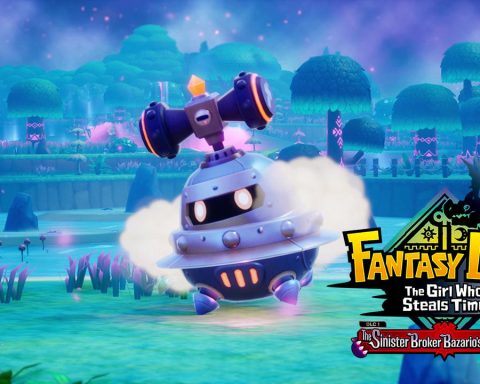Level-5 has, for the longest time now, been hesitant to localise its Yo-Kai Watch franchise into western markets. One presumes that the underlying reason for that hesitancy is due to the intense cultural relevance the Yo-Kai games have to Japan, and the assumption that a great deal of the underlying themes driving these games to their wild popularity in Japan (and “wild popularity” is an understatement; you can’t walk three steps in Japan at the moment without encountering Yo-Kai Watch merchandise) would generally be missed or ignored in the west.
Related reading: This review refers to Pokemon a great deal due to the similarities between the two. Read a review of a recent Pokemon game to catch yourself up.
But Nintendo, on the hunt for a new hit to supplement the Pokemon phenomenon that is showing signs of being eclipsed and waning, decided to work with Level-5 to take on the mammoth localisation task for the first in the Yo-Kai series. The results are great, though I do suspect that Yo-Kai Watch remains too “Japanese” for the western kids it needs to sell over this way, and I can’t see this hitting the commercial highs outside of Japan that Pokemon has enjoyed.
Like Pokemon, Yo-Kai Watch is a game about collecting and battling monsters. These yokai are, in Japanese tradition, natural spirits that don’t generally play so well with humanity, though they are less malevolent (as opposed to Oni – demons), and more mischievous. However, as the story begins, the little boy or girl that you choose as your avatar discovers that he or she has the ability to bend yokai to his or her will. And from there the young adventurer sets out on an epic quest to waste away his or her summer break helping her friends through their difficulties by using his or her yokai to battle the more mischievous members of the species.
Unlike Pokemon, which has an adventure play out in a similar format to a traditional JRPG, where players will travel between towns on their way towards an ultimate end-challenge, Yo-Kai Watch’s adventure plays out in the suburbs of a Japanese city. “Dungeons” are dark alleys behind convenience shopping streets, or “secret paths” through thickets of trees. “Quests” involve mundane activities like tracking down your father’s lost business papers before he gets himself in trouble at work. This world has plenty of combat and activity (the father forgot his papers because a mischievous yokai ate his short-term memory), but it’s framed within a very normal, domestic environment.
For Japanese kids, this is exciting wish-fulfilment stuff. Given much greater independence from the family from a young age, Japanese kids do spend a lot of time during their holidays roaming around town by themselves to do their activities. They play sport, complete projects that require trips to the museum, and so on, largely on their own initiative and without requiring their parents to drag them around everywhere. The addition of yokai aside, this world of this game, and the activities within it mirrors the real kid’s own experience of summer, and that context of normalcy is a big part of what makes the game so interesting to them.
For western kids, the experience might not be as familiar. Suburban life in Japan is different, so the visual aesthetics are also different, but more to the point is that western kids tend to be more closely monitored and managed by adults. The environment of Yo-Kai Watch won’t be as immediately familiar to western kids, and while the narrative still works as a fantasy, I don’t believe they’ll connect with it quite as powerfully as a result.
The yokai themselves are another challenge the game might find in resonating with western kids. To compare again to Pokemon; in that game the monsters are typically very Japanese but it doesn’t necessarily matter. For example, Farfetch’d, the duck that carries a spring onion around, is the manifestation of a joke in Japan, but while that joke doesn’t really exist in the west, the character remains cute enough that kids can appreciate it anyway. Yokai, meanwhile, are also very Japanese – every Japanese kid knows what a frog-like kappa is, for example – but the appeal in battling and catching these creatures is more in knowing exactly what they are. i.e. “I just got a Kappa!”. Some of the yokai are fine – we all know what a Cerberus is, for example – but for quite a few of them, I don’t think the typical western kid will care as much. It’s like asking someone who knows nothing about Greek mythology to appreciate what a feat taking down Cronos must be.
Mind you, in the game’s defence, Nintendo and Level-5 has done a masterful job in translating their names, however. Similar to what Square Enix does with Dragon Quest, a lot of the names of the monsters are based on clever word play, which is always difficult to localise. I was kept chuckling as I met new monsters through the entire adventure, however, because the way these names have been translated into English are really quite clever.
A final point where I can easily see Yo-Kai Watch falling flat with western kids is in its sense of humour. Heck, parts of the game might downright concern parents that are monitoring what their kids are playing. One early quest tasks players with retrieving an old man’s underwear: a man the characters had only just met, at that. To do that, they need to go into a public bath, whereby they get into a brawl with a rather bloated, half naked monster, while a bunch of men, wearing nothing but towels, dance a truly surreal little jig in the background. I was playing the game with the girl protagonist and… yeah, that kind of humour doesn’t exactly translate down this way. I laughed at the weirdness of it all, but then I’ve spent so long in Japan I know that’s an approach to humour. To again compare to Pokemon, which also has a sense of humour, but one that is more universal, Yo-Kai Watch will feel to many western kids as falling flat when it tries to be funny.
Now, with all of that said, none of it is an actual criticism of Yo-Kai Watch. I find it strange that it has been localised, because I really do not believe the game belongs in the west, but putting aside cultural context, it really is quite brilliant. It’s funny, it’s cute, it’s charming. It’s nostalgic, too, for those of us who remember what it is like to be kids and playing hero in our mundane world. I remember once on a walk through a park my mother lost a valued necklace, and we backtracked everywhere we went, scouring the place for the necklace. If I had have had a collection of monsters, and got them into a scrap or two while looking for that necklace, I would have basically just completed a Yo-Kai Watch sub-quest, and again, while that might sound mundane, it’s precisely its connection to real-life experiences that makes it so appealing.
I also liked the way the game is subtly educational. For example, crossing the major roads through the map without waiting for pedestrian lights to turn on is a bad idea, because doing it too often will cause a ridiculously powerful Oni demon to show up and start chasing your character down.
And I found the narrative itself greatly charming. It, too, deals with largely domestic issues, and does so from a child’s view on the world. You’ll help a friend find his mother’s ring that he lost in a lake trying to use is as a fishing lure because he’s worried that his mother will no longer see any reason to remain with his father as a consequence… only to find that after retrieving the ring, the mother was simply leaving town for a weekend to attend a class reunion, and the ring wasn’t that valuable to her anyway. While Yo-Kai Watch is a game firmly for children – even more so than Pokemon – it’s these little thematic insights and analysis into the life and perspective of children – as well as a nostalgia for childhood – that gives it some value for an adult audience as well.
As a monster-collecting JRPG, Yo-Kai Watch is a great deal more simple than its peers, such as Persona 4, Dragon Quest Monsters, and (of course) Pokemon. In this game, you don’t have direct control of each of the three monsters that participate in battle. They will use their own skills as they feel like it, and instead, your job is to feed them food in real time to keep their health up, choose which enemy for them to target, and then play a little minigame on the bottom of the 3DS’ screen to activate their most powerful abilities. There’s some time management involved, as enemies do tend to do a lot of damage if left unchecked for just a couple of moments, and the special power minigame tends to take a lot of time and focus to activate, but otherwise it’s a fairly hands-off system.
Much of the strategy happens outside of battle, with equipable items that offer significant character statistics changes – both positive and negative, as well as the placement of the yokai relative to one another in the battle formation. Critters like to fight with others of their own kind, you see. It’s also possible to fuse two different monsters together into one more powerful creature, which fans of Persona or Dragon Quest Monsters will be instantly familiar with, though there is less variety to the output here.
Simple as it is, the combat system is immensely engaging, and it helps that each of the monsters has been constructed with such care and personality that it’s impossible not to stick each new critter in the team for at least a battle or two in order to see how they behave in a scrap.
Dungeon design is also simple, but interesting, with some basic puzzles to break up the linear movement through them. There’s also a large open world to explore in Yo-Kai Watch, with loads of side quests to complete, and incentive to go back to already completed dungeons, as most of them have doors that can only be bypassed after reaching a certain strength level, and hold better loot and tougher enemies behind them.
So, while Yo-Kai Watch is pitched firmly at children, I found it to be utterly delightful, absorbing, and lengthy. I’m about 60 hours in, at the end of the main quest, but still have enough side quests to keep me going for a while. I can’t see it resonating quite so powerfully in the west, and certainly Pokemon’s extreme depth and competitive scene isn’t going to be threatened by the gameplay on offer here. At the same time, there is a much stronger emphasis on the human characters, narrative, and setting in this adventure, and on that side of things, I haven’t seen a game better suited for children (but one the adults can still enjoy) for quite some time.
– Matt S.
Editor-in-Chief
Pokemon or Yo-Kai Watch?
— Digitally Downloaded (@DigitallyDownld) December 10, 2015












